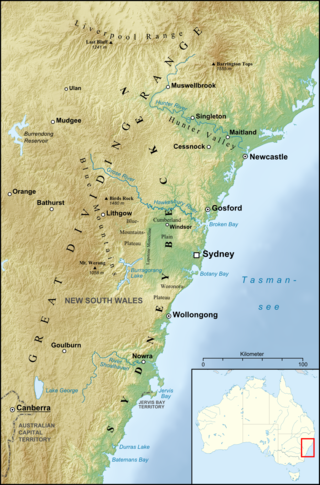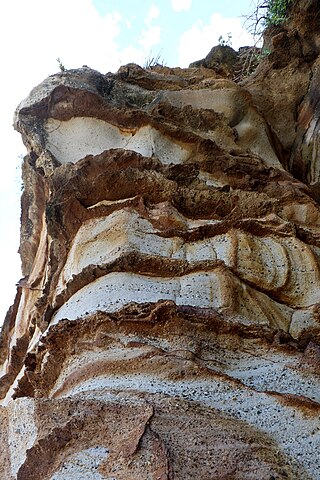
The Wollemi National Park is a protected national park and wilderness area that is located in the Central West and Hunter region of New South Wales, in eastern Australia. The 501,703-hectare (1,239,740-acre) park, the second largest national park in New South Wales, contains the 361,113-hectare (892,330-acre) Wollemi Wilderness – the largest such wilderness area in Australia – and is situated approximately 130 kilometres (81 mi) northwest of Sydney.

The Sydney Basin is an interim Australian bioregion and is both a structural entity and a depositional area, now preserved on the east coast of New South Wales, Australia and with some of its eastern side now subsided beneath the Tasman Sea. The basin is named for the city of Sydney, on which it is centred.

The Narrabeen group of sedimentary rocks occurs in the Sydney Basin in eastern Australia. This series of rocks was formed in the Triassic Period.

The Mittagong Formation is a sedimentary rock unit in the Sydney Basin in eastern Australia.

The Illawarra Coal Measures is a group of sedimentary rocks occurring in the Sydney Basin in eastern Australia. This stratum is up to 150 metres thick. Formed in the Late Permian, it comprises shale, quartz-lithic sandstone, conglomerate rocks, and chert, with sporadically carbonaceous mudstone, coal and seams of torbanite. Coal mining of these measures remains a significant commercial enterprise to the present day. One of the abandoned coal mines in the Blue Mountains is now a tourist attraction.

Bald Hill Claystone is a sedimentary rock found in the Sydney Basin in eastern Australia. It is part of the Clifton sub-group of the Narrabeen Group of sedimentary rocks. It was formed by weathering of the Gerringong Volcanics in the early Triassic. Named after Bald Hill, in the northern Illawarra, where it is 15 metres thick. The claystone is easily noticed at Long Reef, where it is 18 metres thick.

Budgong Sandstone is a lithic sedimentary rock occurring in the Sydney Basin in eastern Australia. This stratum is up to 370 metres thick. Formed in the Late Permian, it consists mostly of tuffaceous material from local Illawarra volcanic rocks. Budgong Sandstone is reddish brown to grey in colour. It creates soils which are associated with rainforest vegetation.

The Newport Formation is a geologic formation outcropping in the Sydney Basin in eastern Australia. This stratum is up to 49 metres thick. Formed in the mid-Triassic, it is part of the Narrabeen Group of sedimentary rocks.

Blue Mountains Basalts are igneous rocks occurring in the Sydney Basin in eastern Australia. This formation is up to 140 metres thick. Formed in the middle Miocene, some 17 million to 14 million years ago.

The Garie Formation is a narrow band of sedimentary rocks occurring in the Sydney Basin in eastern Australia. This stratum is up to 8 metres thick, situated below the sandstones of the Newport Formation. Formed in the mid-Triassic, it is part of the Narrabeen Group of sedimentary rocks. Garie formation consists of layers of clay pellet sandstone, dark lithic particles, spotted volcanic deposits and chocolate coloured claystone bands.

Bulgo Sandstone is a sedimentary rock occurring in the Sydney Basin in eastern Australia. This stratum is up to 100 metres thick, formed in the early Triassic (Olenekian). A component of the Narrabeen Group of sedimentary rocks. It consists of layers of fine to medium-grained quartz-lithic sandstone, with lenticular shale interbeds.

Mount York Claystone is a narrow band of sedimentary rocks occurring in the Sydney Basin in eastern Australia. This stratum is up to 13 metres thick. Mount York Claystone consists of red brown claystones, of fine‐grained and coarsely oolitic, kaolinite clayrocks.

Burra-Moko Head Sandstone is a type of sedimentary rock occurring in the Sydney Basin in eastern Australia. This stratum is up to 112 metres thick. The rock is composed of quartzose to quartz lithic sandstone. It is situated below the Mount York Claystone in the Blue Mountains. Formed in the early Triassic, it is part of the Narrabeen Group of sedimentary rocks.

Munmorah Conglomerate is a geologic formation in the Sydney Basin in eastern Australia. This stratum is up to 140 metres thick. Formed in the early-Triassic, it is part of the Narrabeen Group of sedimentary rocks. This formation includes medium to coarse-grained sandstone and conglomerate. With minor amounts of siltstone and claystone. Below the Munmorah Conglomerates are Newcastle Coal Measures, originating from the Permian.

The Terrigal Formation is a geologic formation in the Sydney Basin in eastern Australia. Commonly seen in the Central Coast region, this stratum is up to 330 metres thick. Formed in the early to mid Triassic, it is part of the Narrabeen Group of sedimentary rocks. This formation includes interbedded fine to medium-grained sandstone and siltstone, with minor deposits of claystone. Hawkesbury Sandstone occasionally overlies the Terrigal Formation. Numerous fossils are known from this area, including the temnospondyl amphibian Arenaerpeton supinatus.

Scarborough Sandstone is a geologic formation in the Sydney Basin in eastern Australia. Commonly seen in the Illawarra region, this stratum is up to 26 metres thick. Formed in the early Triassic, it is part of the Narrabeen Group of sedimentary rocks. This formation includes quartz-lithic sandstone, sometimes with pebbles.

Stanwell Park Claystone is a geologic formation in the Sydney Basin in eastern Australia. Commonly seen in the Illawarra region, this stratum is up to 79 metres thick. Formed in the early Triassic, it is part of the Narrabeen Group of sedimentary rocks.This formation includes red, green and grey shale with quartz-lithic sandstone.

The Caley Formation is a band of sedimentary rocks occurring in the Sydney Basin in eastern Australia. This stratum is up to 46 metres thick. The formation consists of claystone, shale and quartz-lithic sandstone. Often seen situated below the Burra-Moko Head Sandstone in the cliffs of the Blue Mountains.

Wentworth Falls Claystone Member is a type of sedimentary rock occurring in the Sydney Basin in eastern Australia. This stratum may be seen above the Banks Wall Sandstone in the Blue Mountains, west of Sydney. Part of the Narrabeen Group of Sedimentary Rocks, formed in the Triassic. Wentworth Falls Claystone Member is composed of thick claystone and siltstone red beds.

Wombarra Claystone is a geologic formation in the Sydney Basin in eastern Australia. Commonly seen in the Illawarra region, this stratum is up to 30 metres thick. Formed in the late Permian to the early Triassic, it is part of the Narrabeen Group of sedimentary rocks. This formation includes grey shale, and minor quartz-lithic sandstone.



















